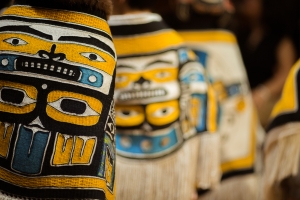SHI to launch project to make mountain goat robe, revitalize horn spoon art practice
Robe to be among first of its kind in circa 200 years
May 1, 2025
Sealaska Heritage Institute (SHI) is launching a project to weave a Chilkat robe made entirely of jánwu (mountain goat) wool for the first time since the 1800s and to revitalize the ancient practice of horn spoon carving—both of which are critically endangered art forms.
Through the project, SHI will teach people how to use all components of a mountain goat, a historically important resource for the region’s Native people. The institute will revitalize the ancient practices of hunting goats; roasting and preserving the meat; rendering the tallow; and harvesting the hides, wool and horns.
“Our people have a relationship to jánwu that will live on in the hunters, weavers and carvers who participate in this project,” said SHI President Rosita Worl. “I think our ancestors would be proud to know we are perpetuating this endangered knowledge.”
Chilkat Robe Project
SHI will recruit weavers and apprentices to create the Chilkat robe, which will live in the institute’s permanent collection in Juneau where it may be studied by artists and danced by future generations.
Participants will learn to separate the mountain goat wool from the hide, spin the material with cedar bark and weave a Chilkat robe.
“The project will foster a new generation of weavers who know how to make Chilkat robes in the ancient way,” said Worl.
Master weavers consulted by SHI were not sure who wove the last Chilkat robe using only jánwu wool, but it’s likely the practice became endangered when commercial wools entered the market on the Northwest Coast roughly 200 years ago.
The late master weaver Teri Rofkar used only jánwu wool in her piece, “Caprini Tribal Regalia,” a geometric Ravenstail robe that won first place in the Customary Inspired category in SHI’s 2014 Juried Art Show and Competition.
Ravenstail weavings, which include intricate and highly complex geometric designs, differ from Chilkat robes, which feature curvilinear shapes such as ovoids. Chilkat weaving, which is unique to Northwest Coast cultures, is one of the most complex weaving techniques in the world.
Rofkar and her sister, master Chilkat weaver Shelly Laws, touched on the differences between commercial and mountain goat wool in Chilkat robes in a video made by the Smithsonian’s National Museum of Natural History.
“I look at the Chilkat [robes] at the museums and try to regain some of that technique, and I keep spinning finer and finer and finer,” Laws said. “And man, I’ve gotten it pretty fine, because I do my own spinning. But doggone it, it just doesn’t look the same. And I’ll weave it, and it still doesn’t look as good as the stuff in the museums. And I’ve come to realize it’s the materials, because they used mountain goat.”
SHI will seek out weavers and apprentices in fall 2025 to work on the robe. It also plans to develop a program for hunters to donate hides to SHI for use by artists.
This might be one of two Chilkat robes made of mountain goat wool in recent times, as a noted Juneau weaver announced her plans this week to make one for a museum in the Lower 48.
Horn Spoon Project
The project also seeks to revitalize the ancient practice of carving spoons from mountain goat horns by training 12 Alaska Native artists to make the pieces.
Traditionally, every family or household group owned dozens of mountain goat horn spoons. Some were more highly decorated for ceremonial use, said the renowned Northwest Coast artist and historian Steve Brown in a video produced by SHI in 2019.
Tribes used the spoons during major ceremonial feasts, or ḵu.éex’, held after the death of a Tlingit or Haida individual. The spoons were used to transfer ceremonial food from serving bowls and plates to smaller dishes and as eating implements by feast participants, according to “Feeding the Ancestors: Tlingit Carved Horn Spoons,” a book sponsored by SHI and published by the Harvard Peabody Museum in 2007.
“They are the most elaborately decorated items used at such feasts and are of great ritualistic significance,” wrote author Victor-Howe, who consulted with Tlingit Elders, scholars and carvers on her research at SHI.
SHI’s robe will be danced for the first time at Celebration 2028, the institute’s biennial dance-and-culture festival. The jánwu horn spoons created by the apprentices will also be on exhibit at the event.
Weavers and carvers who participate in the project will be eligible for six and three credits, respectively, from the University of Alaska Southeast.
CONTACT: Kathy Dye, SHI Communications and Publications Deputy Director, 907.321.4636, kathy.dye@sealaska.com.
Captions: Top: Contemporary child-sized Chilkat robes unveiled at a Juneau event in 2023. Bottom: “Caprini Tribal Regalia” Ravenstail robe by Teri Rofkar is the only known contemporary weaving made of jánwu wool. No one has woven a Chilkat robe of mountain goat wool since the 1800s. Photos by Sydney Akagi and Brian Wallace, respectively, courtesy of Sealaska Heritage Institute. Note: Media outlets are permitted to use these images for coverage of this story. For higher-res images, contact kathy.dye@sealaska.com.
